Eclipse 2024
April 15, 2024
North America experienced a
total eclipse on April 8, 2024, and the path of
totality went through the
United States, giving easy access for viewing by the many people willing to
travel a short
distance.
Weather this time of year is always problematic; so, there were no
guarantees for good
viewing. I did my
graduate study at
Syracuse University (Syracuse, New York), which was very near the region of totality. However,
Tikalon's Northern New Jersey location was quite a distance from the region of totality. Still, the
intensity of
sunlight at my location was expected to be reduced by 92% at maximum
occlusion.
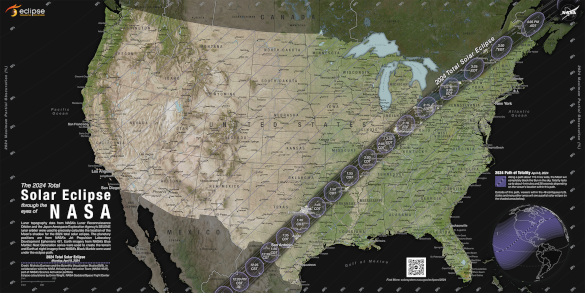
Path of totality for the solar eclipse of April 8, 2024. (Image by NASA’s Scientific Visualization Studio , Michala Garrison (SSAI) and Ernie Wright (USRA), visualizers, with technical support from Laurence Schuler (ADNET Systems, Inc.) and Ian Jones (ADNET Systems, Inc.). Click for larger image.)
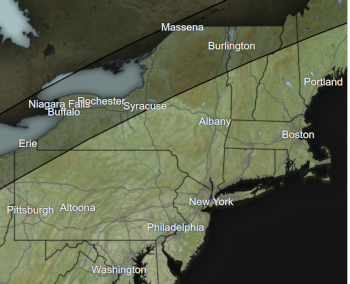
Path of totality for the solar eclipse of April 8, 2024 near the New York metropolitan area.
New York City was forecast to see a 90% partial solar eclipse starting at 2:10 PM EDT and lasting until 4:36 PM EDT, for a total of two hours and 26 minutes. (Portion of a NASA image. Click for larger image.)
There was a North American
solar eclipse on August 21, 2017, for which the New York metropolitan area experienced just a 70% reduction in light intensity. For that eclipse, I conducted a simple
experiment to
monitor the
sky brightness and
air temperature that I detailed in a
previous article (Partial Solar Eclipse at New Jersey, August 24, 2017). This year, I was distracted by the
Easter holiday, and I didn't plan to make any measurements. However, I was
inspired on the morning of April 8, 2024, to
cobble together a very simple device for measurement of the sky brightness using a
photovoltaic cell and an
aperture limiting
tube that monitored a 1.33
steradian (Sr) patch of sky. (see figures)
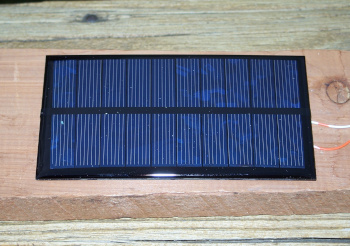
Polycrystalline silicon photovoltaic cell, one of a batch of devices I purchased from Amazon for another project.
The active region is 100 mm x 50 mm.

I used a small piece of PVC pipe to limit the aperture of the photovoltaic cell. Only the central region of the cell was exposed to light, the rest being masked. The pipe limited the measurement to a 1.33 steradian (Sr) patch of sky. (Click for larger image.)
Photovoltaic cells are not an ideal choice for
photometry, since they have a
nonlinear response. I suspect that my
loading of the cell with a 1000
ohm resistor may have helped with the linearity, but I haven't
verified this
hypothesis. The following figure shows the
voltage vs illumination data for the photovoltaic cell. I did this measurement by moving a
light bulb on a
linear rail away from the photovoltaic cell and applying the
inverse-square law to calculate the relative illumination.
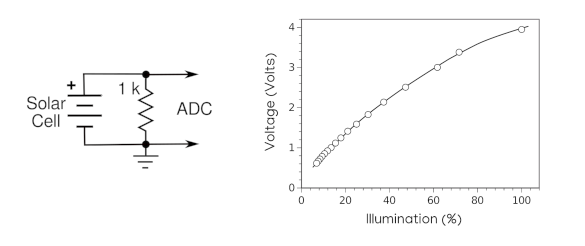
voltage versus illumination response for a polycrystalline silicon photovoltaic cell. The cell was loaded with a 1000 ohm resistor; and, a light bulb, initially five inches from the cell, was moved along a linear rail to a final distance of 21 inches. The inverse-square law was applied to calculate the relative illumination of the cell. (Click for larger image.)
The final figure shows the
raw data from my measurement. It was an expectedly
cloudy day, and the clouds caused dips in the
photometric data. The eclipse at our 40.8768°
North Latitude, 74.6566°
West Longitude, location was
forecast to begin at 2:09 PM EDT (14.15 hours) and end at 4:36 PM EDT (16.6 hours) with a maximum occlusion of 91.8% at 3:24 PM EDT (15.40 hours). As can be seen from the data, the time of maximum occlusion matched the predicted time quite closely.
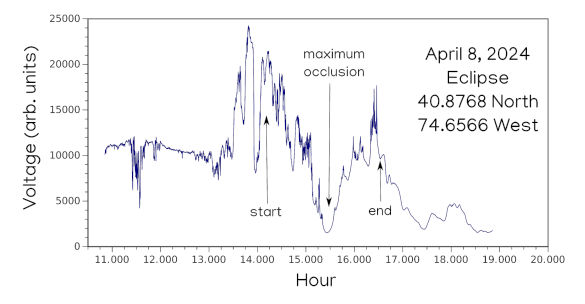
Sky brightness data for the solar eclipse of April 8, 2024. This is the raw voltage data. There are expected dips caused by passing clouds, but the measured time of maximum occlusion (15.433 hours) matched the predicted time of 15.40 hours quite well. (Click for larger image.)
Linked Keywords: North America; total eclipse on April 8, 2024; totality; United States; travel; distance; weather; guarantee; observational astronomy - Important factors; viewing; graduate school; graduate study; Syracuse University (Syracuse, New York); Tikalon; Northern New Jersey; intensity (physics); sunlight; occultation; occlusion; solar eclipse of April 8, 2024; totality; NASA’s Scientific Visualization Studio; New York metropolitan area; New York City; forecast; Eastern Time Zone - Daylight saving time; EDT; hour; minute; solar eclipse on August 21, 2017; experiment; real-time data; monitor; sky; brightness; air temperature; Easter holiday; inspiration; inspired; cobble together; solar cell; photovoltaic cell; aperture; tube (fluid conveyance); steradian (Sr); polycrystalline silicon; FellDen-Photovoltaic-Polycrystalline-110mmx60mm-5V-200mA; millimeter; mm; aperture-limiting cylider for photovolyaic cell; polyvinyl chloride; PVC; pipe (fluid conveyance); mask; photometry (optics); linearity; nonlinear response; electrical load; loading; ohm (unit); resistor; verify; hypothesis; volt; voltage; LED lamp; light bulb; linear rail; inverse-square law; voltage versus illumination response for a polycrystalline silicon photovoltaic cell; light; illumination; inch; calculation; calculate; raw data; cloud cover; cloudy day; photometric; North Latitude; West Longitude; sky brightness data for the April 8, 2024, solar eclipse; data; prediction; predicted.